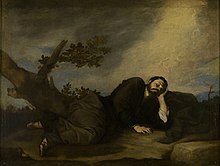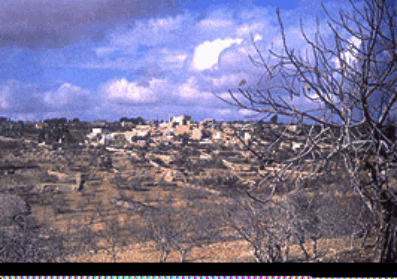BETHEL was an ancient city once located between the territories of Benjamin and Ephraim and was originally the Canaanite city known as Luz . Bethel, meaning "House of God", was named by Jacob, (son of Isaac; grandson of Abraham) after fleeing from the wrath of his brother Esau. He falls asleep on a stone and dreams of a ladder stretching between Heaven and Earth and thronged with angels; God stands at the top of the ladder, and promises Jacob the land of Canaan; when Jacob awakes he anoints the stone (baetylus) with oil and names the place Bethel.

Bethel is mentioned several times in Genesis. It is first mentioned in Genesis 12, but the best-known instance is Genesis 28 [Jacob fleeing from Esau]. Another account, from Genesis 35 repeats the covenant with God and the naming of the place (as El-Bethel), and makes this the site of Jacob's own change of name to Israel. Both versions state that the original name of the place was Luz, a Canaanite name.
Where it's exact location is still remains a mystery, although there are many theories as to its locale.
Eusebius of Caesarea and Jerome describe it in their time as a small village that lay 12 Roman miles north of Jerusalem, to the right [or east] of the road leading to Neapolis.
Bethel escaped destruction during the Assyrian conquest of Israel (721 BC), but was occupied by King Josiah of Judah (c.640–609 BC), who, according to the book of Kings, destroyed the ancient Israelite cult centre because of their unholy practices of worshipping the "golden calf".
Edward Robinson (1794-1863) was a renouned biblical scholar of his time and identified the village of Beitin in Palestine with ancient Bethel in Biblical Researches in Palestine, 1838–52. He based this assessment on its fitting the location described in earlier texts, and on the philological similarities between the modern and ancient name, arguing that the replacement of the Hebrew 'el' with the Arabic 'in' was not unusual. Beitin is located 10 miles north of Jerusalem. (Edward Robinson is pictured on the Right)
Ten years after the short-lived Six Day War of June, 1967, the biblical name of Bethel was applied to an Israeli settlement Beit El constructed adjacent to Beitin. Coincidently, a second biblical Bethel, in the southern portion of Judah, is mentioned in the Book of Joshua ( Joshua 8:17 and Joshua 12:16 ), and seems to be the same as Bethul or Bethuel, a city from the ancient tribe of Simeon.
According to Robinson, Bethel was once again inhabited after its destruction in the BC era and fortified by Bacchides the Syrian in the time of the Maccabees. Josephus tells us that Bethel was captured by Vespasian. Robinson notes that after the writings of Eusebius and Jerome, he found no further references to Bethel in the written historical record. However, he notes that the ruins at Beitin are greater than those of a village and seem to have undergone expansion after the time of Jerome, noting also the presence of what appear to be ruins of churches from the Middle Ages.
The Ruins of Al-Burj in Beitin, Palestine
"But do not seek Bethel, nor enter Gilgal, nor pass over to Beersheba; for Gilgal shall surely go into captivity, And Bethel shall come to nothing." Amos 5:5
However, in 2008, David Livingston, PhD refuted the actual location of ancient Bethel as well as Edward Robinson's findings. According to the Associates for Biblical Research Blog, Dr. Livingston is quoted as saying:
"Most scholars today locate Old Testament Bethel at the Arab village of Beitin about 11 mi north of Jerusalem. An examination of the evidence, however, indicates that this identification in incorrect. It is important to correctly locate Bethel because Ai is located with relation to Bethel (Gn 12:8; Jos 7:2), and finding Ai has been a major focus of ABR’s research work.
How was Beitin originally identified as Bethel? Edward Robinson was the first to identify it in the 1830's. He equated the modern Arabic name of "Beitin" with "Bethel" (which is feasible, but not compelling). Actually, there was no village at the site in Robinson's day. Apparently, it was an area name rather than a village name. In fact, for over 1400 years the very name "Bethel" had been completely forgotten in the area."
How was Beitin originally identified as Bethel? Edward Robinson was the first to identify it in the 1830's. He equated the modern Arabic name of "Beitin" with "Bethel" (which is feasible, but not compelling). Actually, there was no village at the site in Robinson's day. Apparently, it was an area name rather than a village name. In fact, for over 1400 years the very name "Bethel" had been completely forgotten in the area."
*Ai was a twin city of ancient Bethel.

The modern village of Beitin, Palestine.
According to Livingston's conclusion, the biblical Bethel is located at El-Bireh (a modern day city situated on the central ridge running through the West Bank and is 860 meters (2,820 ft) above sea level, covering an area of 22.4 square kilometers (8.6 sq mi). Its name means “Water Well,” and is believed to be derived from the biblical "Beeroth".
The modern city of El-Bireh, Palestine
"Taking into consideration the topography of the area, its strategic placement in controlling the north-south roads, mileage measurements, and Roman milestone studies, Biblical Bethel should be found under modern El-Bireh. There does not seem to be any substantial reason to any longer equate Beitin with ancient Bethel." - David Livingston
For more information about Livingston's theory please visit the following link: http://www.biblearchaeology.org/post/2008/04/locating-biblical-bethel.aspx#Article



No comments:
Post a Comment